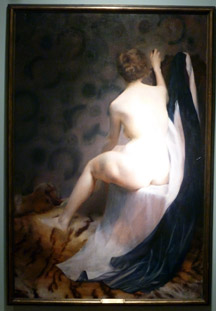“Circles,” (New Britain Museum, 1928) by Polly Ethel Thayer (1904-2006)
“Circles” won a major prize, establishing her career as a painter when she was 24. Known for her very skillful portraits, Polly Ethel Thayer lived to be a hundred-one years old.
But this is very different from the portrayals of Bostonian women in the 1920s. It is a mysterious painting with a powerful shape and form that take advantage of the contrast of the high-key nude with the dark brooding qualities of the drapery–as well as with the darkness of the room itself.
The circles of the title are implied throughout. That the circles are incomplete is central to the significance of the painting. From a distance the nude and her white drapery mimic the shape of a waxing moon, an echo of the feminine metaphors of the moon prevalent throughout classical imagery and classical literature.
The nude is cushioned on the right with a dark drapery which, mysteriously, protects her. Her body, from her right hand to her left foot, cuts a brazen diagonal across the canvas–a diagonal of brilliant high-key flesh suggestive of the great nudes of the post-impressionists. But this nude is virtually academic in detail and realization. Because the dominant painting styles of the great Europeans of the age were the antithesis of academic, Polly Ethel Thayer (her married name was Starr) remained a local genius.
This nude shows how a woman–rather than a man of the age–could capture a woman’s mystery and create a sense of profound significance transcending the erotic, avoiding the maternal, all while implying a cosmic feminine life force that defies the dark.
